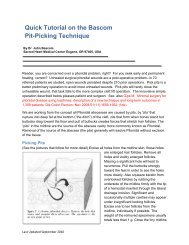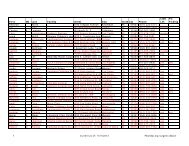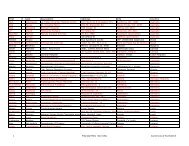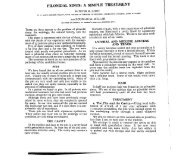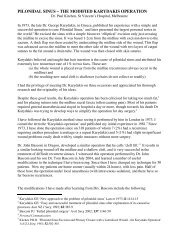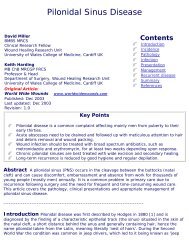Kitchen_10_Modified Karydakis.pdf - Pilonidal Disease
Kitchen_10_Modified Karydakis.pdf - Pilonidal Disease
Kitchen_10_Modified Karydakis.pdf - Pilonidal Disease
You also want an ePaper? Increase the reach of your titles
YUMPU automatically turns print PDFs into web optimized ePapers that Google loves.
anaesthesia (with intravenous sedation), and 4 under spinal anaesthesia and there have been 5<br />
(2%) recurrences.<br />
The modifications I have made after learning from Drs. Bascom include the following:<br />
1. The operation can be performed with a liberal usage of local anaesthesia (and adrenaline)<br />
which is preferable to general anaesthesia in the prone position. This is possible in nonnervous<br />
patients if the sinus not too large, and it can be done as a day-case. Give plenty<br />
of time to insert LA slowly under IV sedation with fine needle. However, my experience<br />
more recently has been that most patients prefer general anaesthesia or spinal anaesthesia<br />
and an overnight stay.<br />
2. The flap should be created first, usually 2cm wide and ~0.75cm deep under the skin<br />
3. Buttock straps should then be removed from the edges of the operating table and the skin<br />
flap gently pulled across the midline with skin hooks to see if the mark of the outer rim<br />
of the ‘ellipse’ has been made correctly on the skin, and to make adjustments to prevent<br />
tension on wound closure. Less may need to be excised from the top end where the cleft<br />
is shallower than lower down.<br />
4. The outer limit of excision is then cut with the scalpel, but instead of going down to the<br />
sacrum (<strong>Karydakis</strong> method), the fat is left and only skin and dermis are excised, until the<br />
sinus is reached.<br />
5. If the cavity is large and deep, the deepest portion of its wall can be left in-situ, and after<br />
curetting it out, and cut into small 1cm cubes so that it will collapse and its sides come<br />
together on closure and help to elevate the cleft (excising a large deep abscess wall may<br />
in fact deepen the cleft on closure rather than make it more shallow).<br />
6. John Bascom has reminded me that <strong>Karydakis</strong> had emphasized the circulation of hairs<br />
from a midline primary pit and through secondary openings. 2 So secondary openings a<br />
distance from the main track do not have to be included in the excision (eg, by making<br />
the wound very large, or by V cuts on one side of the wound to close and result in a T-<br />
shape as I once advocated 6 ). Rather, the tracks can be curetted, and the openings cleaned<br />
out and enlarged a bit, and hair particles removed by curettage and pulling gauze through<br />
them, to and fro. Once the primary pit is dealt with, the secondary pits should left to<br />
drain and will heal, and any hairs in them should make their way out.<br />
7. The flap should fit gently across the midline on the fat rolled in from the other side over<br />
the suction drain tube brought out well laterally. A few fine PDS or vicryl sutures are<br />
used in the fat and need not be inserted down to the sacral fascia.<br />
flap<br />
collapsed<br />
cavity in<br />
depth<br />
I use the term ‘<strong>Modified</strong> <strong>Karydakis</strong>’ rather than ‘Cleft Lift’ or ‘Bascom II’ because the basis of<br />
the operation is the original work of <strong>Karydakis</strong> (who deserves the recognition), and to prevent<br />
confusion with the simpler operation previously described by John Bascom. 7<br />
I have found the modified <strong>Karydakis</strong> operation (or cleft lift) is an improvement on the original<br />
<strong>Karydakis</strong> procedure because it uses sensible plastic surgical principles (in preparation of the<br />
flap first), it only removes what is necessary (preserves most of the fat to help elevate the cleft)<br />
and is less painful (no deep sutures). Also it can sometimes be done under LA as a day-case.<br />
6 <strong>Kitchen</strong> PRB ‘<strong>Pilonidal</strong> Sinus - Experience with the <strong>Karydakis</strong> Flap’ Br J Surg 1996; 83:1452-55<br />
7 Bascom JU ‘<strong>Pilonidal</strong> <strong>Disease</strong>: longterm results from follicle removal’ Dis Colon Rectum 1983; 26:800-7



